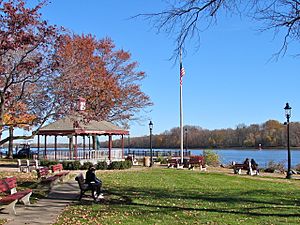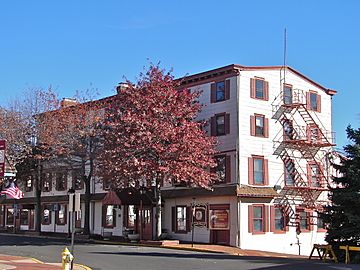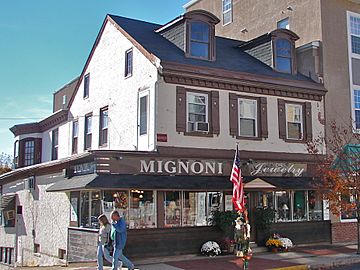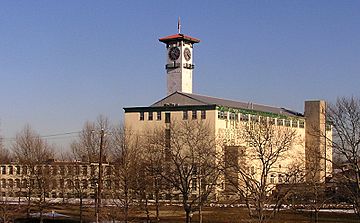Bristol, Pennsylvania facts for kids
Quick facts for kids
Bristol, Pennsylvania
|
|
|---|---|

Lions Park on the Delaware River
|
|

Location of Bristol Borough in Bucks County, Pennsylvania.
|
|
| Country | United States |
| State | Pennsylvania |
| County | Bucks |
| Settled | 1681 |
| Area | |
| • Total | 1.96 sq mi (5.07 km2) |
| • Land | 1.70 sq mi (4.40 km2) |
| • Water | 0.26 sq mi (0.67 km2) |
| Elevation | 20 ft (6 m) |
| Population
(2010)
|
|
| • Total | 9,726 |
| • Estimate
(2019)
|
9,576 |
| • Density | 5,632.94/sq mi (2,174.54/km2) |
| Time zone | UTC-5 (Eastern (EST)) |
| • Summer (DST) | UTC-4 (EDT) |
| ZIP Code |
19007
|
| Area codes | 215, 267, and 445 Exchanges: 781,785,788,826,874 |
| FIPS code | 42-08760 |
|
Pennsylvania Historical Marker
|
|
| Designated: | January 13, 1949 |
Bristol is a borough in Bucks County, Pennsylvania, 23 miles (37 km) northeast of Center City Philadelphia, opposite Burlington, New Jersey on the Delaware River. It predates Philadelphia, being settled in 1681 and first incorporated in 1720. After 1834, it became very important to the development of the American Industrial Revolution as the terminus city of the Delaware Canal, providing greater Philadelphia with the day's high tech anthracite fuels from the Lehigh Canal via Easton. The canal and a short trip on the Delaware also gave the town access to the mineral resources available in Connecticut, New Jersey and New York via each of the Morris Canal, the Delaware and Hudson Canal, and the Delaware and Raritan Canal, and connected the community to those markets and trade from New York City.
Although its charter was revised in 1905, the original charter remains in effect, making it the third-oldest borough in Pennsylvania after Chester and Germantown. It had 7,104 residents in 1900; 9,256 in 1910; 10,273 in 1920; and 11,895 in 1940. The most recent 2010 census showed its population at 9,726. Its current mayor is Joseph A. Saxton. It is served by SEPTA's Trenton Line.
History
Samuel Clift founded Bristol, having received a land grant from Governor Edmund Andros of New York. The grant became effective on March 14, 1681 (new style) or March 4, 1681 (old style) at the same time as William Penn's Charter from Charles II became effective. Clift was required by the grant to maintain ferry service across the Delaware River to Burlington, New Jersey, and to run a public house or inn. The inn later became known as the George II.
Bristol was platted in 1697, and named after Bristol, England. It was originally used as a port and dock. Bristol is rich in history, boasting many historic and restored houses that line the streets of Radcliffe and Mill.
Until 1725 Bristol served as county seat of Bucks County.
From its earliest days Bristol was a center of textile mills, foundries, milling, and miscellaneous manufacturing. With the building of the 60 miles (96.6 km) long, forty feet wide, and five feet deep Delaware Canal—it became a transshipment gateway connecting the anthracite barges flowing down the Lehigh Canal's end terminal at Easton to Philadelphia. Bristol was chosen to terminate the Delaware Canal because it already had regular shipping connections to other parts of Philadelphia and Delaware River ports by both the era's typical animal powered barges and era typical coastal/inland shipping vessels. Its docks also had regular ferry services to New Jersey and other points east from as early as 1681 until 1931, and the town would receive early steamboat service as that technology came to be.

The expense of digging the canal was justifiable as the banks of the Delaware southerly from Easton were less suitable, there was insufficient real estate for extensive additional docks, so the legislature figured the Delaware Canal avoided the need to transship barge loads of coal to boats, drastically saving costs and time. Since Bristol's long established docks were accessible to the Delaware, the town also became the Delaware Canal's southern (main distribution) terminal end. Consequently, later, the Pennsylvania Railroad would also connect to the anthracite flowing through the canals, to the riverine barge and boat traffic, and to provide rail depots servicing the manufacturies. Even before the canal, Bristol was located along a main land route to New York City, Trenton, and New England so with construction of the canal and railroads, it became a major center of transportation and an even more attractive location for industry.
By the 1880s Bristol was home to many factories, including companies manufacturing wall paper and carpet. In World War I, the Bristol docks had sufficient space for a shipyard to construct twelve building slips for the construction of merchant vessels. In 1917 Averell Harriman organized the Bristol shipyards founding the Merchant Shipbuilding Corporation (later called Merchant-Sterling) and given the U-boat menace, would land a contract to build 40 identical cargo ships for the war. The residential area that developed around the shipyards was soon named Harriman, Pennsylvania, and most of the housing built therein is still in use today. In 1922 Harriman was annexed by Bristol. Most of the shipping was finished too late to enter World War I, but some of the shipyard's output was used post-war in relief and troop support missions. The majority of the contracts were canceled in 1919, and the ship yards rapidly became excess real estate. Between the world wars, the eighty-acres of the shipyard were let out to various concerns, including one area converted to building amphibious planes—the flying boats technology which was the heart and soul of long distance air travel until the technological advances theretofore the middle years of World War II.
During World War II the old shipyards were used to build those and other airplanes, but most of the manufacturing in WW-II was not directly war related.
In 1961, Bristol gained national attention when the song "Bristol Stomp", by The Dovells hit #2 on the Billboard pop chart. The song remains a local favorite, and it is often played at ceremonies, parades, and sporting events. The Merchant Shipbuilding site returned to the news in the 1990s when the Bucks County Redevelopment Authority using state and federal funding targeted the area as a priority for urban redevelopment.
Given its riverfront location, the old shipbuilding site was ranked highest in priority, and on 20 October 2000 various legislators and officials held a press conference at the former shipyard heralding the construction of the residential development already under way, known as the 'Riverfront North Project', and publicizing how derelict portions of the slipways were being removed. The project also established a park with four monuments celebrating the towns past in the redevelopment.
Today the preserved elements of the shipyard, and other buildings once important in Bristol's past service are enshrined and celebrated in the Bristol Historic District, Bristol Industrial Historic District, and tourism sites celebrating the towns history and rich ethnic diversity. Various annual festivals, in particular keep a multi-ethnic cultural identity alive and well.
Historic sites in the town such as the Delaware Division of the Pennsylvania Canal, Dorrance Mansion, General Stores and Mold Loft Building-Harriman Yard of the Merchant Shipbuilding Corporation, Grundy Mill Complex, Harriman Historic District, Jefferson Avenue School and Jefferson Land Association Historic District are listed on the National Register of Historic Places. Delaware Division of the Pennsylvania Canal is also designated a National Historic Landmark District.
Tourism
Attractions include the Bristol Riverside Theatre, and the Margaret R. Grundy Library and Museum. In the summer there are many festivals and free concerts. The cultural festivals include: Celtic Day, Puerto-Rican Day, African-American Day, and Italian Day (with a Doo-Wop Concert). There is also an Antique Car Show, Arts & Crafts Festival, and a Fall Auto Show. All held at the Bristol Lions Park, Bristol Wharf and in the Historic Mill Street Shopping District by the Delaware River.
Silver Lake Park and Nature Center provides an area of recreation.
Geography
Bristol is located at 40°6′12″N 74°51′5″W / 40.10333°N 74.85139°W (40.103382, -74.851448).
According to the United States Census Bureau, the borough has a total area of 1.9 square miles (4.9 km2), of which, 1.6 square miles (4.1 km2) of it is land and 0.2 square miles (0.52 km2) of it (10.81%) is water.
Demographics
| Historical population | |||
|---|---|---|---|
| Census | Pop. | %± | |
| 1800 | 511 | — | |
| 1810 | 628 | 22.9% | |
| 1820 | 908 | 44.6% | |
| 1830 | 1,262 | 39.0% | |
| 1840 | 1,438 | 13.9% | |
| 1850 | 2,570 | 78.7% | |
| 1860 | 3,314 | 28.9% | |
| 1870 | 3,269 | −1.4% | |
| 1880 | 5,273 | 61.3% | |
| 1890 | 6,553 | 24.3% | |
| 1900 | 7,104 | 8.4% | |
| 1910 | 9,256 | 30.3% | |
| 1920 | 10,273 | 11.0% | |
| 1930 | 11,799 | 14.9% | |
| 1940 | 11,895 | 0.8% | |
| 1950 | 12,710 | 6.9% | |
| 1960 | 12,364 | −2.7% | |
| 1970 | 12,085 | −2.3% | |
| 1980 | 10,867 | −10.1% | |
| 1990 | 10,405 | −4.3% | |
| 2000 | 9,923 | −4.6% | |
| 2010 | 9,726 | −2.0% | |
| 2020 | 9,861 | 1.4% | |
| Sources: | |||
As of a 2014 estimate, the borough was 69.2% Non-Hispanic White, 16.4% Black or African American, 1.5% Native American and Alaskan Native, 0.2% Asian, 3.5% Some other race, and 3.4% were Two or more races. 15.0% of the population were of Hispanic or Latino ancestry
As of the 2010 census, the borough was 81.1 White, 9.5% Black or African American, 0.2% Native American, 0.6% Asian, and 3.5% were two or more races. 14.2% of the population were of Hispanic or Latino ancestry. There are 661 veterans living in Bristol Borough.
As of the census of 2010, there were 9,726 people, 4,237 households, and 3,926 families residing in the borough. The population density was 6,016.5 people per square mile (2,322.0/km2). There were 4,207 housing units at an average density of 2,550.8 per square mile (984.4/km2).
There were 4,004 households, out of which 28.0% had children under the age of 18 living with them, 39.7% were married couples living together, 15.9% had a female householder with no husband present, and 39.0% were non-families. 33.3% of all households were made up of individuals, and 14.3% had someone living alone who was 65 years of age or older. The average household size was 2.48 and the average family size was 3.20.
In the borough the population was spread out, with 24.5% under the age of 18, 8.8% from 18 to 24, 30.5% from 25 to 44, 20.5% from 45 to 64, and 15.7% who were 65 years of age or older. The median age was 36 years. For every 100 females, there were 90.6 males. For every 100 females age 18 and over, there were 88.3 males.
The median income for a household in the borough in 2016 was $42,962. Males had a median income of $28,653 versus $19,278 for females. About 8.2% of families and 16% of the population were below the poverty line.
Education
The Bristol Borough School District comprises two public schools: Warren Snyder-John Girotti Elementary School (K-6) and Bristol High School (7-12). Other schooling opportunities in Bristol are offered through the Roman Catholic parish school of St. Mark Church (K-8), located in the borough. Conwell-Egan Roman Catholic School in Fairless Hills, Pennsylvania provides private/parochial schooling for children in grades 9-12. Higher education in Bristol Borough includes Pennco Tech.
Transportation
U.S. Route 13 passes southwest-northeast through Bristol on Bristol Pike, heading southwest toward Bensalem and Philadelphia and northeast toward Levittown and Trenton, New Jersey. US 13 connects to the Pennsylvania Turnpike (Interstate 95) at the Delaware Valley interchange north of Bristol, just west of the Delaware River–Turnpike Toll Bridge over the Delaware River that connects the Pennsylvania Turnpike to the New Jersey Turnpike. Pennsylvania Route 413 passes north-south along the western edge of Bristol, heading north on Veterans Highway toward Langhorne and south to the Burlington-Bristol Bridge over the Delaware River that leads to Burlington, New Jersey. PA 413 connects to Interstate 95 at an interchange north of Bristol.
The Bristol station is served by SEPTA Regional Rail's Trenton Line that provides service between Center City Philadelphia and the Trenton Transit Center. Trains along Amtrak's Northeast Corridor pass through Bristol but do not stop; the nearest Amtrak station is in Trenton. SEPTA provides Suburban Bus service to Bristol along Route 128, which runs between the Neshaminy Mall and the Oxford Valley Mall, and Route 129, which runs between the Frankford and Knights Bus Loop in Northeast Philadelphia and the Oxford Valley Mall. TMA Bucks operates the Bristol Rushbus, which offers peak-hour shuttles between a connection with the Trenton Line train at the Bristol station and certain businesses in Bristol.
Notable people
- Poul Anderson, science fiction writer
- Daniel W. Bursch, astronaut
- John F. Cordisco, former State Representative and Bucks County Democratic Committee Chairman
- Jeffrey Costello, fashion designer
- Tony DiStefano, motocross national champion
- John Thompson Dorrance, founder of Campbell Soup Company
- Ileen Getz (August 7, 1961 – August 4, 2005), actress
- Joseph R. Grundy (January 13, 1863 – March 3, 1961), textile manufacturer, politician, U.S. Senator
- William Edward Hanford (December 9, 1908 – January 27, 1996), chemist
- Lauren Holly, actress
- Jeff Manto, professional baseball player
- Joe McEwing, professional baseball player
- Joseph McIlvaine (October 2, 1769 – August 19, 1826), United States Senator
- Mike Missanelli, Philadelphia sports personality
- William Rodman (October 7, 1757 – July 27, 1824), United States Congressman
- Charlie Saxton, actor
- Will Thomas, novelist
- David Todd, record promoter and producer
- Joanna Fox Waddill, Civil War nurse; known as the "Florence Nightingale of the Confederacy"
- Todd Weiner, professional football player
See also
 In Spanish: Bristol (Pensilvania) para niños
In Spanish: Bristol (Pensilvania) para niños






